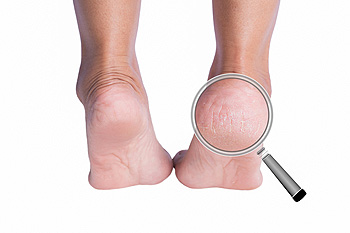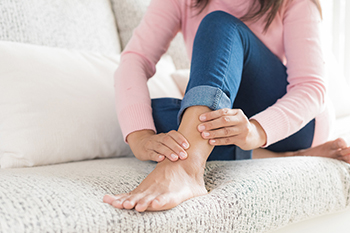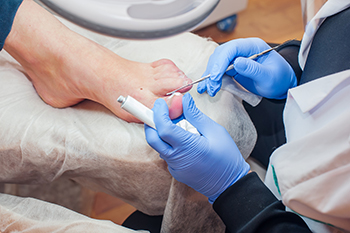Items filtered by date: April 2022
Cracked Heels Begin with Dry Skin

Cracked heels develop when skin on the heels is first allowed to become dry. It can then thicken and harden. This callused skin is more prone to cracking when the weight of the body bears down on the skin, causing it to break. It is important to keep the skin on your feet hydrated and healthy. Avoid wearing open-backed shoes that expose your heels to the elements. Staying in the water for too long can actually dry your skin out, so limit showers and baths to 5-10 minutes. Use gentle cleansers that don’t strip your skin from natural oils. Lock in moisture right after bathing by applying foot cream with alpha hydroxy acid or salicylic acid. Moisturizing your feet at night and covering them with socks while you sleep can also help heal cracked heels. However, those who are elderly or have diabetes should not try to treat cracked heels at home. These individuals, as well as those whose cracked heels have not improved with home treatment, should seek the professional care of a chiropodist.
Cracked heels, also known as heel fissures, can cause pain and discomfort. If your cracked heels are bothering you, please consult with Chiropodist Stephanie Poupore from North Bay Foot & Ankle. Our clinician will assess your condition and provide you with quality foot and ankle treatment.
Dry, thickened skin around the rim of the heel is typically the first sign of cracked heels. While this condition is common and usually just a nuisance, some cases can be more severe. If left untreated and as more pressure is placed on the heel, the cracks become deeper and eventually walking and standing can be painful. These deep cracks or fissures can bleed and also become infected. Those with diabetes need to be especially careful as fissures could lead to diabetic foot ulcers.
Causes
Cracked heels can be the result of several different factors, including:
-
Dry skin
-
Taking long, hot showers or using harsh soaps
-
Standing for long periods of time
-
Walking barefoot
-
Walking in shoes with an open back, such as sandals or flip flops
-
Wearing shoes that do not fit properly
-
Living in a cold or dry climate
-
Certain skin conditions, such as eczema or psoriasis
Treatment
There are many at-home treatment remedies for cracked heels. Applying moisturizers to the heel can help hydrate the skin. Soaking your feet in warm water and exfoliating them with a loofah or pumice stone can help to buff away dead skin cells. If you are afflicted with cracked heels, it is recommended that you see a chiropodist for treatment.
Prevention
You can prevent cracked heels by:
-
Avoiding standing in one position for prolonged periods of time
-
Wearing well-fitted shoes with a closed back
-
Washing your feet with gentle soaps and lukewarm water
-
Moisturizing the feet daily
If you have any questions, please feel free to contact our office located in . We offer the newest diagnostic and treatment technologies for all your foot care needs.
Are Bunions Affecting Your Everyday Life?
What Is a Talar Dome Lesion?
 A talar dome injury is usually caused by an ankle sprain, where the cartilage that covers the talus bone in the ankle is damaged. Sometimes, if the cartilage does not heal correctly, a piece of it breaks off. Symptoms, which may take months to develop, include chronic pain when bearing weight or playing sports, a clicking feeling when walking, a feeling that your ankle is giving way when you step down, and swelling that subsides at night. Because the source of the pain is hard to pinpoint, this injury can easily be overlooked and the symptoms remain unexplained. Non-surgical treatments include immobilizing the ankle in a boot, taking non-steroidal anti-inflammatory medication, and wearing an ankle brace for stability. If you have problems with lingering ankle pain, it is suggested that you see a chiropodist as soon as possible for an examination.
A talar dome injury is usually caused by an ankle sprain, where the cartilage that covers the talus bone in the ankle is damaged. Sometimes, if the cartilage does not heal correctly, a piece of it breaks off. Symptoms, which may take months to develop, include chronic pain when bearing weight or playing sports, a clicking feeling when walking, a feeling that your ankle is giving way when you step down, and swelling that subsides at night. Because the source of the pain is hard to pinpoint, this injury can easily be overlooked and the symptoms remain unexplained. Non-surgical treatments include immobilizing the ankle in a boot, taking non-steroidal anti-inflammatory medication, and wearing an ankle brace for stability. If you have problems with lingering ankle pain, it is suggested that you see a chiropodist as soon as possible for an examination.
Ankle pain is a common symptom of many lower limb problems. If you are experiencing ankle pain, please consult with Chiropodist Stephanie Poupore from North Bay Foot & Ankle. Our clinician will assess your condition and provide you with quality foot and ankle treatment.
The ankle is composed of a number of muscles, bones, tendons, and ligaments. There are many conditions which may cause ankle pain.
Causes
-
Ankle strains or sprains
-
Achilles tendon injuries
-
Fractures
-
Bursitis
-
Arthritis
-
Gout
-
Tarsal tunnel syndrome
Symptoms
If you have ankle pain, you may also experience a variety of other symptoms depending on the underlying cause of the pain. Some of these symptoms may include ankle swelling, bruising, redness, numbness or tingling, instability, and difficulty walking.
Diagnosis
The underlying cause of ankle pain can be diagnosed by a chiropodist. Diagnoses are typically made based on your medical history, a physical examination of the affected ankle, and imaging studies such as X-rays.
Treatment
Treatment for your ankle pain will depend on its underlying cause. Often, the chiropodist will recommend that you rest the affected ankle. You might also need to ice, compress, and elevate the ankle, wear an orthotic device, or take medications to reduce pain and inflammation.
If you have any questions, please feel free to contact our office located in . We offer the newest diagnostic and treatment technologies for all your foot care needs.
Protecting Your Toenails From a Fungal Infection
Yellow, brittle, split, or thickened toenails are usually due to a fungal nail infection. There are a variety of microscopic organisms that can cause a fungal infection, which typically enter the nail through tiny cuts in the skin or between the nail bed and nail. A fungal toenail infection can be very difficult to get rid of at home, as the fungus can get in between the layers of nail and even deep under the nail in the nail bed. There are several things you can do to keep nails protected from these fungal invaders. First, never share personal items with anyone such as nail clippers, socks or towels: the fungus can live on these items for some time. The fungus can also stay viable for months in warm, moist environments such as communal showers, locker rooms, and pool areas, so you should always wear flip flops to avoid contact with surfaces in these areas. Avoid nail injuries by trimming your nails straight across—but not too short. Keep your feet clean and dry, change your socks daily, and allow wet sneakers or shoes at least a day to dry out before wearing them again. If you have developed a toenail infection, consult with a chiropodist who has professional level treatments to fully and permanently eradicate any toenail fungus.
Toenail fungus can be uncomfortable and unsightly. If you have diabetes or a compromised immune system, it may also be dangerous. To learn more about treatment options, please consult with Chiropodist Stephanie Poupore from North Bay Foot & Ankle. Our clinician will assess your condition and provide you with quality foot and ankle treatment.
What Does Toenail Fungus Look Like?
A fungal infection of the toenail may cause the affected nail to become thickened, brittle, crumbly, and yellowish or brown in color. Sometimes the toenail may separate from the nail bed, become deformed, emit a foul odor, or cause pain or discomfort.
What Causes Toenail Fungus?
Toenail fungus is caused by a fungus that infects the nail bed. The fungus lives and thrives in warm and moist environments and is also contagious. Athlete’s foot, which is a fungal infection of the skin, may spread to the nails and cause toenail fungus.
What Treatments Are Available?
Potential treatments for toenail fungus may include oral antifungal medications, topical antifungal medications, such as medicated nail polishes that are applied directly to the affected nail, and laser therapy. Sometimes, a combination of treatments is prescribed.
If you have any questions, please feel free to contact our office located in . We offer the newest diagnostic and treatment technologies for all your foot care needs.
Read more about Treating Toenail FungusIs Athlete’s Foot Contagious?
 Athlete's foot typically appears at the bottom of the foot and between the toes. Common symptoms can include flaky, dry and red skin, and the foot is often itchy. In severe cases, small blisters may develop. It is caused by a fungus that enters the skin through small cracks in the feet. This particular fungus lives and thrives in warm and moist environments, including public pools, shower room floors, and locker rooms. It is a contagious foot condition, and it is advised to refrain from sharing towels, shoes, and socks. It is beneficial to wear shoes that are made of breathable materials, and to wear appropriate shoes while in places where this fungus can live. If you have athlete’s foot, it is suggested that you speak with a chiropodist who can properly treat this condition.
Athlete's foot typically appears at the bottom of the foot and between the toes. Common symptoms can include flaky, dry and red skin, and the foot is often itchy. In severe cases, small blisters may develop. It is caused by a fungus that enters the skin through small cracks in the feet. This particular fungus lives and thrives in warm and moist environments, including public pools, shower room floors, and locker rooms. It is a contagious foot condition, and it is advised to refrain from sharing towels, shoes, and socks. It is beneficial to wear shoes that are made of breathable materials, and to wear appropriate shoes while in places where this fungus can live. If you have athlete’s foot, it is suggested that you speak with a chiropodist who can properly treat this condition.
Athlete’s foot can be uncomfortable and unsightly. To learn more about preventing and treating this condition, please consult with Chiropodist Stephanie Poupore from North Bay Foot & Ankle. Our clinician will assess your condition and provide you with quality foot and ankle treatment.
What Is Athlete’s Foot?
Athlete’s foot refers to an infection of the skin on the feet that is caused by a fungus. This fungus is contagious and thrives in warm and moist environments. It is often spread in common areas such as public pools, locker rooms, and showers. It can also spread when sharing personal items, like shoes or towels, with an infected person.
Symptoms
The symptoms of athlete’s foot may include:
-
Itching, stinging, or burning of the skin on the feet
-
Cracking or peeling skin, especially between the toes and on the soles of the feet
-
Scaly, red rash on the foot
-
Blisters
-
Foul odor
Treatment
Treatment for athlete’s foot typically involves using over-the-counter topical antifungal medications on the feet. When over-the-counter options are ineffective, you may need to take prescription oral medications or topical antifungal drugs, or a combination of both.
Prevention
Preventing athlete’s foot places an emphasis on good foot hygiene practices.
You can prevent athlete’s foot by:
-
Washing and drying your feet thoroughly every day
-
Wearing shoes when walking in public areas
-
Not sharing personal items, like shoes or socks, with others
-
Wearing shoes and socks made out of breathable materials
If you have any questions, please feel free to contact our office located in . We offer the newest diagnostic and treatment technologies for all your foot care needs.


